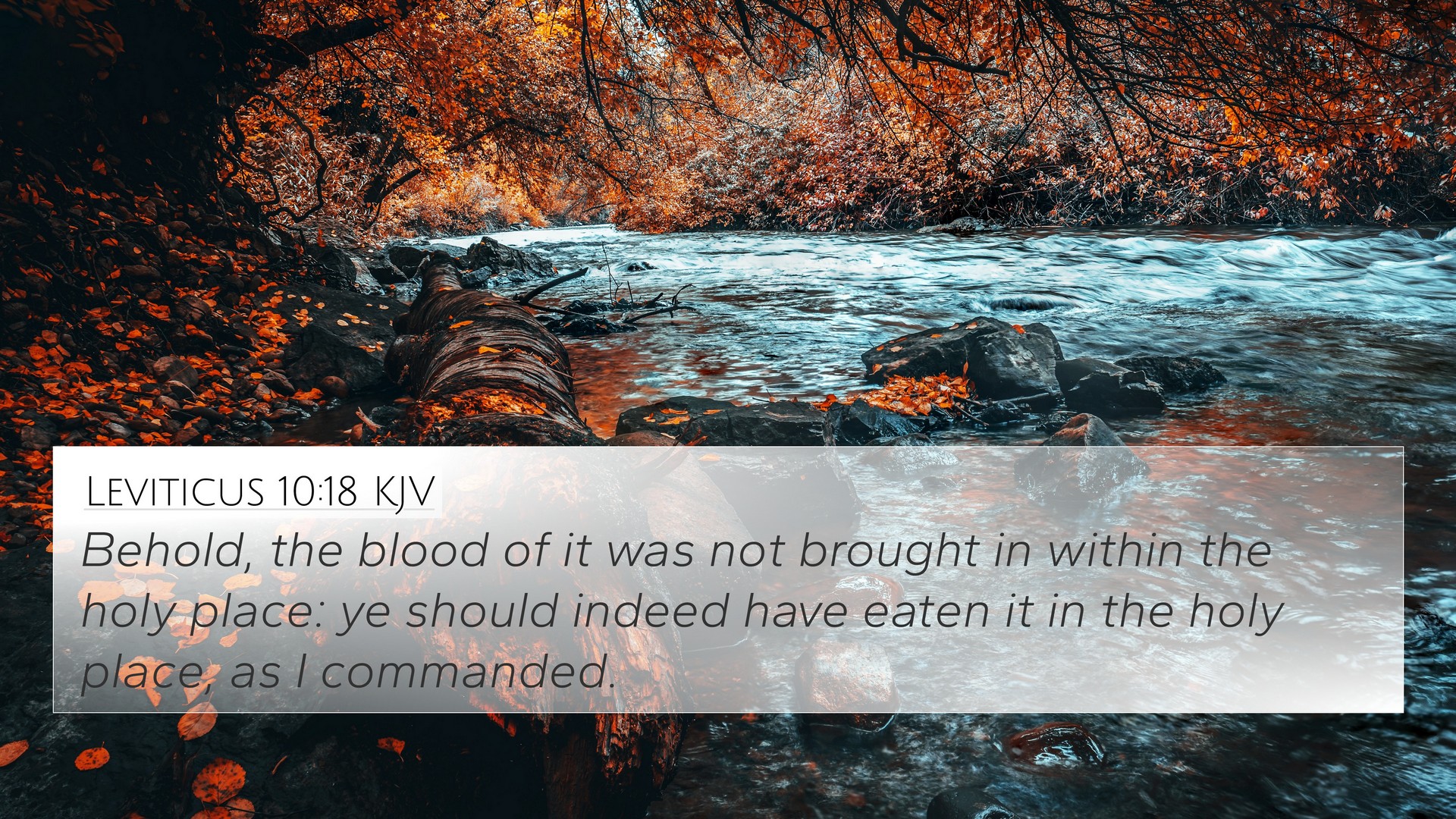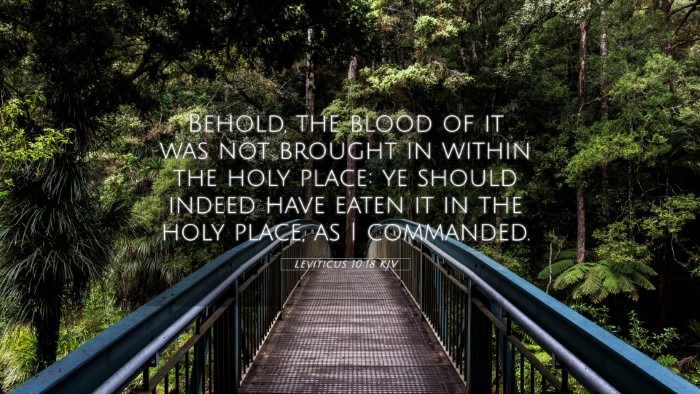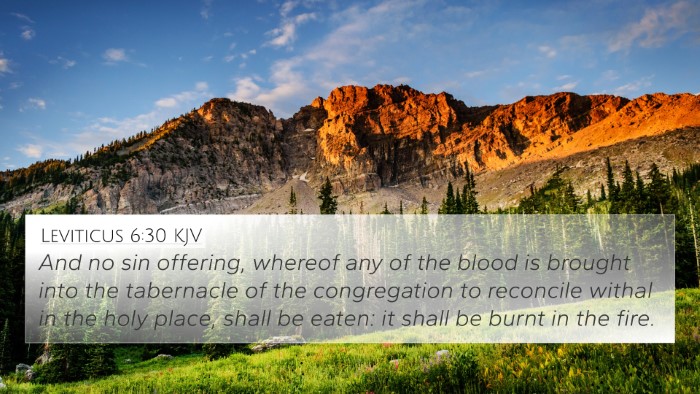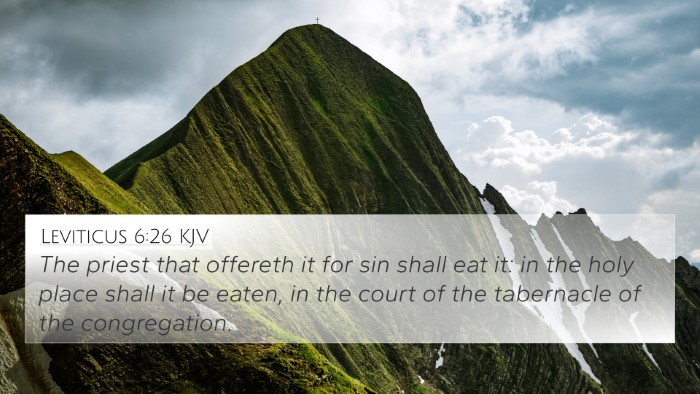Understanding Leviticus 10:18
Verse (Leviticus 10:18): "But the flesh of the sacrificial animals and their blood were not brought into the tent of meeting; they were burned up on the altar as a sin offering."
This verse captures a critical moment in the Levitical system of sacrifices and their corresponding rituals, reflecting not just obedience to God’s commands but the deeper implications of means of atonement and holiness demanded of the priests.
Exegesis and Commentary Insights
-
Matthew Henry: Henry notes that this verse highlights the necessity of following God's instructions precisely in sacrificial practices. The flesh and blood, integral parts of the offerings, signify the seriousness of sin and the gravity of the atonement required. The preferred elements being burnt signify purification and the removal of sin.
-
Albert Barnes: Barnes emphasizes the sanctity of the sacrificial system, indicating that the flesh and blood symbolize the life and essence of the offerings made to God. His interpretation revolves around God’s desire for adherence to His commands to highlight the people’s need for atonement and set apart holiness.
-
Adam Clarke: Clarke provides an analysis of the symbolic implications of sacrifices. He posits that the burning of the offerings outside the tent signifies the externalization of sin and impurity, embodying the spiritual principle that sin must be removed entirely from the camp of the faithful.
Bible Verse Parallels and Cross-References
This verse connects deeply with several other scripture passages that explore themes of sacrifice, atonement, and purification in both the Old and New Testament:
- Exodus 29:14: Discusses the burning of the flesh and the importance of removing sin offering parts outside the camp.
- Hebrews 13:11-13: Represents the fulfillment of sacrificial systems in Christ, as He suffered outside the gate to sanctify the people.
- Leviticus 4:11-12: Details the manner of disposing of sin offerings, reinforcing the ritualistic integrities required in the sacrificial laws.
- 1 Peter 2:24: Discusses Christ bearing our sins, illustrating how Christ’s sacrifice fulfills the Old Testament sacrificial roles.
- Isaiah 53:5: Prophetic insight related to Jesus’ suffering and sacrifice prophesied as a sin offering to humanity.
- Romans 3:25: Explores the concept of atonement through faith in Christ, connecting to the significance of blood in sacrificial imagery.
- Matthew 5:23-24: Calls to reconcile with one’s brother, drawing a link between holiness and the necessity of right relationships before offerings.
Thematic Connections and Interpretative Framework
The relationship among these verses reflects a thematic continuity from the Old Testament sacrificial system to New Covenant theology:
- Sin and Atonement: The necessity of blood as a means of atonement covers both ceremonial practices and Christ's ultimate sacrifice.
- Holiness and Separation: The practice of burning sacrificial remains outside of the camp emphasizes God's continuous demand for holiness and purity among His people.
- Faith and Obedience: The adherence to God’s precepts in Leviticus is mirrored in New Testament teachings on living according to faith.
Tools for Bible Cross-Referencing
To fully appreciate the depth and interconnections of scriptures such as Leviticus 10:18, various tools and methods can enhance understanding:
- Bible Concordance: Search for related words or themes, allowing for exploration of similar verses across scripture.
- Bible Cross-Reference Guide: Provide insight into related verses, cultivating a comprehensive understanding of scripture context.
- Bible Study Methods: Utilize comparative studies, thematic exploration, and inter-Biblical dialogue to reveal deeper meanings.
User Intent Keywords for Further Exploration
Many seek deeper understanding by asking:
- What verses are related to Leviticus 10:18?
- Find cross-references for Leviticus 10:18 to comprehend its significance better.
- How do Leviticus 10:18 and Hebrews 13:11-13 connect?
Conclusion
The exploration of Leviticus 10:18 through biblical cross-references not only enhances knowledge of sacrificial systems but also illustrates the enduring principles of atonement, obedience, and holiness. Each verse serves as a thread in the larger narrative of scripture, providing clarity and context as believers seek meaning and understanding in their faith journey.




